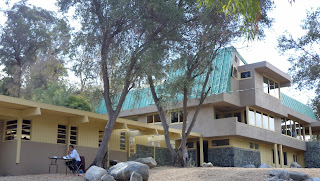My mother was quite the
artist when she was a teenager, growing up in NYC. So talented, in fact,
that—according to family lore—she was offered a scholarship to study with
Spanish surrealist Salvador Dalí,
when she graduated from high school. Instead, she came to California, where she
met my father and, at age 19, became a housewife and mother, like everyone
else. Nevertheless, as a kid I was smitten by the romantic notion of
what-might-have-been and became fascinated by the works of Salvador Dalí.
Two of Mom's best paintings (click on image to enlarge)
The Disney Family Museum
is currently featuring an exhibit on Dalí and
his relationship with Walt Disney. An odd pair, to be sure, but the museum does
an excellent job of paralleling the subversive art of both men, until 1937 when
Dalí proclaims, in a letter, that he’s going to California to meet one of his
favorite “fellow surrealists,” Walt Disney! They eventually decide to work on a
film together, Destino,
animated by Dalí, but you can no doubt figure out how that particular story
ends (think: Mickey Mouse vs. dripping clocks).
Dalí painting
Despite their differences, the
two cultural giants remained friends and, in the late 1950s, visited each
other’s homes. My favorite photo
in the entire exhibit shows a very regal and straight-backed Dalí riding the narrow-gauge
train, Lilly Belle, in Walt’s Brentwood backyard.
Dalí
The exhibit runs till
January 3, 2016. Highly recommended!
**************
P.S. In addition to the Dalí,
there is also a small but wonderful exhibit,
about Disneyland’s Tomorrowland, in the basement of the main museum. Quotations,
photos and footage from the old Disney TV shows capture Walt’s vision of the
future.
Hip couple of the future
Drawing of my beloved Monsanto House
And, of course, me




























































